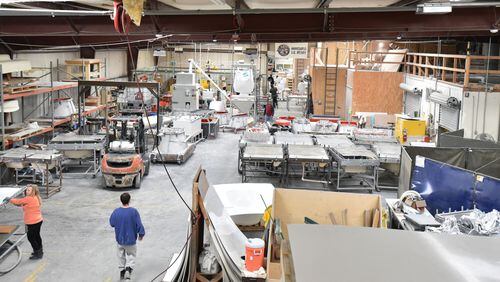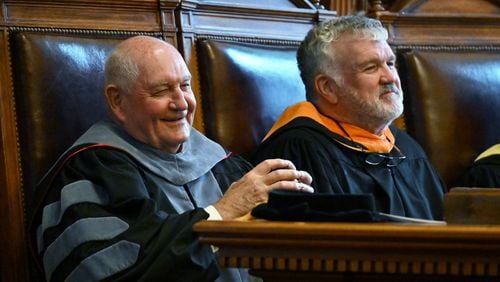Manufacturing jobs in Georgia
2005 — 451,500
2006 — 437,300
2007 — 425,800
2008 — 388,000
2009 — 344,600
2010 — 346,900
2011 — 351,200
2012 — 356,400
2013 — 360,600
2014 — 370,400
2015 — 377,002
Source: Bureau of Labor Statistics
It’s a chilly morning in Buford, but Nick Sysol is generating some warmth as he polishes a $6,000 bathtub.
Sometimes the customer wants a matte finish. That takes Sysol about four hours of polishing. And sometimes – like for this tub – the buyer prefers a glossy finish. That’s another four hours.
Sysol, 21, who works in the Buford plant of MTI, prefers the more time-intensive demand of a glossy finish.
“At the end of the day, you see the thing that you’ve done and you can take pride in what you do. You want it to be quality, the same quality that you’d like to have. And I like high quality stuff.”
One shift, one tub. It’s not what you would call mass production, but it’s the kind of niche business that keeps many Georgia manufacturers going.
MTI cannot compete with low-wage labor in an overseas factory. It cannot match a factory using a cookie-cutter approach with the work done by robots.
It doesn’t try.
“This is mass customization, and that takes people,” said Kathy Adams, MTI’s chief executive. “We wouldn’t do well with vanilla widgets.”
American manufacturing workers once made up nearly one-third of the entire workforce, a share that has been shrinking for years. In Georgia, the sector now has 32 percent fewer workers than in late 1998.
Manufacturing now accounts for just 8 percent of Georgia jobs. Still, that is a lot of people: 377,200 workers. And while metro Atlanta is dominated by services, logistics and various corporate work, it also has 42 percent of the state’s manufacturing jobs.
During the decades since manufacturing’s peak, the nation has lost millions of jobs to cheap, overseas labor, while many others have been taken by more efficient processes, automation and robots.
Harbors in a storm
Survival means finding one of the sheltering harbors that have survived the global storm: MTI’s is to sell high-end products, depending on workers with skill – and an incentive to get things right.
There are others. You can be an arm of a large, multinational company, like say, Alcon in Duluth, which makes eye-care products. You can fine-tune the work, customizing to your customer in a way no low-wage off-shore factory can, like Metcam, a metal parts fabricator in Alpharetta.
You can cater to a local market, like 60-year-old Greenwood Ice Cream.
So long as the American and Atlanta economies are growing and consumers are spending, Greenwood should be okay, said Mitchell Williams, chief executive.
“When the economy is bad, people go out less, so we are not completely immune. But domestically, we probably look better now than we’ve been for a long time. A lot of the economic numbers look good.”
Greenwood sells to consumers, businesses and restaurants. Williams has run the 25-employee firm for about a quarter century.
“You can’t eliminate market risk – There is only so much you can do,” he said. “But we are very aggressive about everything.”
With expansion in mind, Greenwood is building a second plant in Norcross.
Global factors
Even a local business cannot escape global factors, Williams said. “I’d give up 25 percent of my sales if I could have good commodity costs. The cost of butterfat is by far the most important thing to me. And raw materials cost is a global issue.”
A small company can’t do much about that. What a company can control – to an extent – is how often they buy materials and how long they hold inventory.
At MTI there’s a constant effort to avoid carrying inventory.
“We don’t make anything until we have an order,” said Russell Adams, company president and son of Kathy Adams, the CEO.. And then we ship it really quickly, which is the key. “Many orders come from hotel and resorts that order several – or several dozen products.
“But sometimes we get a one-off,” he said. “We had one for Tyler Perry – he wanted the eight-foot tub from ‘Scarface.’”
In production itself, there’s a reliance on workers’ skills, and on their judgment.
Robots would have trouble seeing the “nuances” in each new mold used to make a tub, Adams said: The material has to be heated to be shaped to the mold, but it can’t be removed from the mold too soon – or too late.
A worker watches carefully, sometimes poking the cooling matter with a gloved hand before making the move.
That timing depends on temperature, humidity and atmospheric pressure among other things, he said. “Some of this is art, some is science. All of these are slightly different.”
Line workers are paid “in the teens” per hour, moving up to $20-plus per hour with experience. But they have another reason to stick around: MTI is owned by employees, and they start receiving stock in the company after two years on the job.
Skin in the game
Toward the end of each year, workers receive a check based on how much stock they have – and how much profit the company made.
Kathy and Russell Adams were both employees when the founder, J.C. Henry, decided to sell the company. It looked like a competitor would buy it, but there was a sticking point – the rival wouldn’t agree to keep MTI’s sales staff on the payroll.
Henry walked away from the deal and turned back to his 35 employees: Did they want to buy the company?
Of course, they’d still have to meet his price.
Some employees cashed in retirement portfolios. Russell Adams refinanced his home. And in 2002, the employees took control. Since then, the company won many awards, most for design.
It has not been easy, Kathy Adams said. “You never relax when you run a business.”
She has two books on her desk – books that every employee is supposed to read: ‘Who Moved My Cheese?’ by Spencer Johnson and ‘Good to Great,’ by Jim Collins.
The idea of the first is to be ready for constant change. And the second is a primer in excellence.
“We changed from our origins as a Walmart company to a Sax Fifth Avenue company, and so we have studied how high-end companies succeed,” said Kathy Adams. “And to stay at the high end, you need employees who have bought into the culture of being the best.”
About the Author






